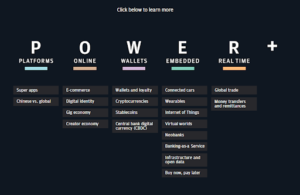
The payments revolution has begun

In 2010, the fastest way to move money on the same day from New York to London was to take it with you on a flight from JFK to Heathrow. Today, you can initiate a secure, real-time payment that’s sent and received into your account in seconds at virtually no cost and in any currency. Not just from New York to London, but from anywhere — including space1 .
Over the next decade, payments will continue to connect people, devices, homes, cars and avatars in ways that span physical and digital worlds. We’re already witnessing the development of these advances converging to make this payments revolution inevitable. In the same way that software served as the bridge between the offline and online world, we expect payments to become the bridge between physical and digital marketplaces.
J.P. Morgan is leading the way with integrated digital payments and cash management solutions that make it easier for businesses to transact with customers, pay employees, suppliers and partners in addition to optimizing working capital on a global scale.
Payments are eating the world
Over the last decade, payments have evolved to a simple equation of connectivity and data transfer. With the emergence of ISO 20022 as a global and open standard for payment messaging, for the first time we will have a common language in which to transact with anyone, anywhere.
Ten years ago, tech investor Marc Andreessen famously proclaimed “software is eating the world”2 — a tongue-in-cheek prediction that turned out to be true. As the world has become globally connected, interoperability and data transfer between platforms, which are at the heart of payments and money movement, will drive the future. Looking ahead, we believe payments will eat the world.
In the next decade, we expect to see revolutionary changes with the introduction of 5G coupled with advances in artificial intelligence (AI) algorithms, quantum computing and blockchain. Such radical innovation will enable new technologies to flourish, including next-gen conversational AI, the Internet of Things (IoT), connected cars, smart contracts and scalable augmented and virtual reality.
As these new technologies are introduced to the marketplace, they will undoubtedly have a profound impact on how we live, work and consume information — shifting value pools and investment allocations, and reshaping our economy.
Empowering better and faster financial decisions in real-time
Norsk Hydro, a global aluminum and renewable energy company sought to add real-time visibility into global liquidity to better monitor financial performance and company growth. A top priority was gaining real-time access to reconciliation information from their J.P. Morgan bank accounts, regardless of time zone or geographical location.
With a traditional treasury setup, however, the Norwegian company received conventional account statements from the house bank only once per day—which only covered the previous day’s transactions. Through collaborating with J.P. Morgan and fintech, Findroids, the company successfully co-created an award-winning custom solution.
Norsk Hydro collaborated with J.P. Morgan and Findroids to develop a bespoke real-time reconciliation package that seamlessly integrated into SAP and connected to J.P. Morgan via APIs.
The solution provides Norsk Hydro with:
- Ready-built SAP adapter to connect to J.P. Morgan’s real-time APIs
- Real-time transaction reporting
- Real-time automated reconciliation in SAP ledgers
- Automated update of cash forecast report during the day
- Faster access to data helping Norsk Hydro compile audit reports that ensure automated day-end reconciliation
“This project proves that the digital transformation of treasury doesn’t need to involve lengthy, expensive and difficult implementations,” said Christian Lingård, Norsk Hydro’s Head of Cash Management. “In just two weeks, we have significantly improved the speed of our reconciliation process and achieved real-time cash visibility across our global accounts.”
Through collaborating with J.P. Morgan and Findroids, Norsk Hydro seamlessly implemented advanced real-time reconciliation capabilities – placing them at the forefront of digital innovation. By adopting a fast and inexpensive digital reporting package, the company enhanced the quality and speed of their real-time cash visibility process while minimizing risk.
What’s next for payments?
The modernization of payments, and the value-added services that surround the transaction, will be crucial for these exciting new business models to become a reality. That’s why we believe that, over the next decade, payments will eat the world.
At J.P. Morgan, we take a holistic and thematic view towards innovation and our payments strategy. In this report, we introduce the POWER+ framework that identifies five mega-themes (Platforms, Online, Wallets, Embedded, and Real Time) and 20 micro-themes that are shaping the future of payments globally

POWER+ represents fast-growing and deep value pools that are early-to-mid stage in terms of maturity. We believe the framework offer tremendous potential in the years ahead as awareness and adoption grows among consumers and merchants.
Discover more about POWER+ and the ways J.P. Morgan is driving the future of e-commerce, please visit jpmorgan.com/payments.
1Reuters, February 2021. ‘JPMorgan’s blockchain payments test is literally out of this world.’ Available at: https://www.reuters.com/article/us-jpmorgan-blockchain-space-idUKKBN2AO1GL. Accessed September 2021.
2Wall Street Journal, August 2011. ‘Why software Is eating the world.’ Available: https://www.wsj.com/articles/SB10001424053111903480904576512250915629460. Accessed September 2021.